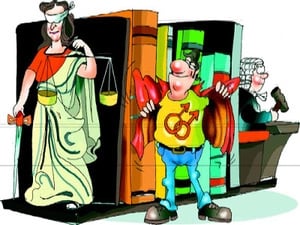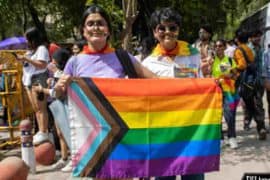What if your options did not have to be between queer ally or queerphobia? What if your options could rather be between flawed and flawed?
TW: Queerphobia
“It is only a pollution instigated by the West!” or “This goes against Indian sabhyata!” are just some of the things you might have heard when the discussion approaches queerness— in any shape and form; statements, that more often than not, have come to become the defensive pedestal of the right-wing, hetero-patriarchal ideology of modern India. But to what extent can it be considered the gospel truth (minus, of course, all the homophobic sub-text)?
From vows of celibacy going hand-in-hand with intimate same-sex friendships, to rebirth in different gender forms, or sex change and the existence of gender fluidity— accounts from ancient India might have been somewhat successful in pulling a thin curtain over the Indian queer reality but that doesn’t make India devoid of queer representation. Mahabharata with its story of Shikhandini or Shikandi, King Bhagiratha with his two mothers, the story of Babur and Baburi, or the existence of an Indianized version of Achilles and Patroclus found in the walls of the Jamali Kamali tomb, all points far away from the fact that India’s “sabhyata” might have only existed in gender binaries.
But that doesn’t mean that living in ancient India as a queer person was a bed of roses; It also had its own share of thorns. With extremes like depictions of same-sex intimate interactions being largely confined to Rakshasas (a literal demonisation of queer identities) to Manu smriti listing a range of quixotic punishments for homosexual men and women, the relation between queerness and Indian history isn’t much less of a Pandora’s box— it might seem all bright and rainbow-coloured from outside but the real horrors only come through when the box finally lies open in your hands.
So, does that mean that all those statements made under the veil of nationalism and rightist ideologies are true? Does it mean that phrases stringed together in hatred and queerphobia are what we need to fall back to?
When the landmark Article 377 verdict was given by the Supreme Court, Rajya Sabha MP Subramaniam Swamy took to telling news channels how “homosexuality is a genetic flaw”. This was the same person who had earlier told the media that “being gay is against Hindutva” and it needs a cure (Source: moneycontrol.com). But couldn’t that easily be just one person’s point of view out of a few hundred? Or is that something only said because the queer community happens to be a huge vote bank nobody wants to lose out on?
It is true that the British came to India and brought something in this regard with them; just that the something wasn’t the reality of queerness but, in contrast, the institutionalisation of queerphobia with the Vatican’s puritanical ideology finding its echo in the anti-sodomy law, something that did not leave India even when the Britishers did.
These two sides of a coin that exist when talks of queer identity travel through the air of India—in whispers or in free cries, in solidarity or in phobia — are as flawed as they are pure. Two rotting but shiny sides, existing as an anomaly in oxymorons, leave you with only one outcome, however impossible: the coin landing on its edge, the coin landing on neither.
Feature Image: economictimes.indiatimes.com
Manasvi Kadian




Comments are closed.